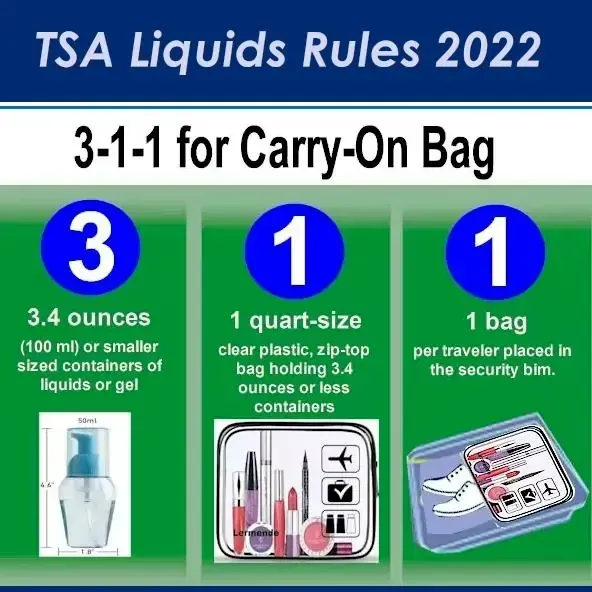U.S. liquid carry-on regulations are under scrutiny as authorities, led by Homeland Security Secretary Kristi Noem, explore potential revisions to existing rules. Currently, these regulations limit the amount of liquids that passengers can bring on board, a policy that has been in place since the early 2000s amidst heightened security concerns. The possibility of easing these restrictions is gaining traction as the government aims to enhance passenger convenience on flights while ensuring effective airport security updates. As we approach travel regulations for 2025, travelers may soon find that their carry-on liquid limit could change dramatically, allowing for a more comfortable journey. This news has sparked significant interest within both the transportation industry and among travelers eager for more convenient flying experiences.
In recent discussions regarding air travel policies, the guidelines governing the carriage of liquids in hand luggage have become a hot topic. These restrictions, which determine how much liquid passengers can carry aboard flights, are being reassessed as part of an ongoing effort to modernize airport security measures. As governmental bodies consider adjustments that could lead to a revamped approach by 2025, travelers everywhere are keenly following these developments. Reports indicate that a potential overhaul of these long-standing rules could enhance the overall convenience of flying, making trips more enjoyable. With the prospect of updated travel regulations on the horizon, passengers and airlines alike are eager to see how these changes will unfold.
Understanding the Current U.S. Liquid Carry-On Regulations
The current U.S. liquid carry-on regulations limit travelers to containers of liquid that do not exceed 3.4 ounces (100 milliliters) per item, with all containers needing to fit comfortably in a single quart-sized bag. This rule, implemented in the early 2000s following heightened security concerns, has become a standard part of the airport security process. Passengers are often seen scrambling at security checkpoints to hastily remove their liquid items from their bags while trying to adhere to these liquid limits.
As a traveler, knowing how to navigate these carry-on liquid limits can be essential for a smooth airport experience. Many frequent flyers have become adept at packing their liquids to conform to these regulations, often investing in travel-sized toiletries and compliant containers. Understanding these regulations is particularly pertinent as travelers prepare for flights, ensuring they can bring necessary items like medications and personal care products without facing confiscation.
Potential Changes to Liquid Regulations and Airport Security Updates
U.S. Homeland Security Secretary Kristi Noem announced on July 19, 2025, that discussions are underway to possibly change or eliminate the liquid limitations for carry-on luggage. This reflection of potential regulatory modernization highlights the evolving landscape of airport security, as authorities seek to balance the necessity of heightened safety with the convenience of air travel. With stakeholders considering how best to adapt, changes to liquid regulations could reshape the passenger experience, moving towards a more passenger-friendly approach.
The ongoing discussions around airport security updates also resonate with the general trend towards improving the traveling experience. As security agencies like the TSA evaluate the effectiveness of existing measures, the possibility of easing certain restrictions reflects broader changes in international travel norms. Securing airports while providing an efficient and convenient passage for passengers is a priority, and the reevaluation of carry-on liquid limits embodies this delicate balance.
As the likelihood of regulatory adjustments in the near future grows, travelers should stay informed about any updates to the current liquid policies. Keeping abreast of developments not only enhances preparedness but also underlines the significance of active passenger engagement with travel regulations.
The Impact of Changing Liquid Limits on Passenger Convenience
If implemented, changes to the current carry-on liquid limit will significantly enhance passenger convenience. Many travelers express frustration at having to forgo larger containers of essential liquids such as sunscreen, beverages, and even personal grooming products during flights. By easing these restrictions, authorities could create a more comfortable flying experience, allowing passengers to bring essentials without the tedious constraints of size limitations.
Moreover, adjusting these regulations could positively affect flight schedules and reduce delays at security checkpoints, as passengers spend less time preparing their bags for screening. Increased convenience at airports aligns with ongoing efforts to improve passenger satisfaction while ensuring that security remains paramount. This potential transformation in liquid regulations may lead to a more streamlined travel process, benefitting both airlines and passengers alike.
Homeland Security News: Future of Travel Regulations in 2025
Part of the ongoing dialogue hosted by U.S. Homeland Security revolves around evolving travel regulations to meet contemporary needs. As international travel rebounds post-pandemic, the need for a review of current protocols, including the carry-on liquid limits, has become increasingly clear. Secretary Noem’s comments underscore a commitment to reevaluating existing measures to determine if they still serve the best interests of security without compromising passenger convenience.
In 2025, it will be essential to monitor not only U.S. regulations but also the ripple effects they may have on Canadian and international travel laws. A potential harmonization of liquid carry-on policies could emerge from these discussions, leading to a standardization that assists travelers across borders. Keeping up with these developments will ensure that travelers are prepared for any upcoming changes in travel policies.
Key Considerations for International Travelers Amidst Regulatory Changes
As international travel resumes, staying informed about changing airport regulations is essential for travelers. The anticipated changes to U.S. liquid carry-on regulations could influence other countries’ policies, prompting travelers to pay close attention to updates. Key considerations include familiarizing oneself with nation-specific regulations since different countries may have shifting rules regarding air travel liquids.
Overall, international travelers should remain proactive by verifying guidelines before embarking on their journey. Understanding these potential changes helps avoid unexpected inconveniences upon arrival at airports. With the evolving nature of carry-on regulations, a well-informed traveler is likely to have a more seamless and enjoyable flying experience.
Airline Perspectives on Liquid Limits and Security Measures
Airlines are closely watching the discussions surrounding U.S. liquid carry-on regulations and their impact on air travel. For carriers, easing liquid limits means adapting to a more relaxed security environment, potentially leading to improved passenger flow and greater satisfaction. This landscape change may allow airlines to highlight enhanced experiences based on convenient travel protocols as they aim to attract more customers post-pandemic.
Carrier advocacy for streamlined security measures may be amplified as consumer expectations evolve. Encouragement for state and federal authorities to reconsider existing policies reflects an industry shift focused on passenger convenience and operational efficiency. Ultimately, a united stance among airlines may facilitate a smoother transition towards updated regulations, making air travel more appealing in the long run.
Preparing for Future Travel: Tips for Navigating Liquid Limits
As you prepare for future travel, being mindful of the current and potential changes to liquid limits is important. Investing in TSA-compliant travel containers is a worthwhile strategy for efficiency during security checks. Ensure your liquids are appropriately contained and easily accessible to streamline the security process, making your airport experience as hassle-free as possible.
Additionally, staying informed through government channels and airline communications about any changes in regulations is crucial. Subscribing to updates from the Department of Homeland Security and your preferred airlines can provide alerts directly to your inbox, ensuring you do not miss any announcements regarding liquid policies or travel regulations.
The Significance of Regulatory Changes for Frequent Flyers
For frequent flyers, changes to carry-on liquid limits could significantly influence their travel routines. The convenience of carrying larger bottles of preferred products—be it shampoo, lotions, or beverages—can enhance their overall experience. By providing greater flexibility in what they can carry, these updates may alleviate some of the stress that regular travelers face when complying with existing limitations.
As advocates of passenger comfort, frequent travelers are ideally positioned to engage in conversations about these enhancements. Reaching out to travel forums and giving feedback offers crucial perspectives that can shape future regulations, thereby influencing the journey of all air travelers.
Conclusion: The Future of Liquid Regulations and Travel Comfort
In conclusion, the potential changes to U.S. liquid carry-on regulations signal a move toward more passenger-oriented approaches in air travel. Balancing security needs with convenience remains a critical discussion point among regulators and the traveling public. As we look toward possible adjustments in 2025, passengers can benefit from staying informed on these important updates.
The evolving landscape of security and travel regulations is a reminder of the constant change within the industry. With patience and awareness, travelers can anticipate a future where regulations enhance their overall flying experience, thus making air travel more enjoyable and efficient for everyone involved.
Frequently Asked Questions
What are the current U.S. liquid carry-on regulations?
Currently, the U.S. liquid carry-on regulations limit passengers to containers of 3.4 ounces (100 milliliters) or less, all of which must fit within a single quart-sized bag. These rules help ensure safety while maintaining some convenience for travelers.
Are there any updates on U.S. liquid carry-on regulations for 2025?
Yes, U.S. authorities, guided by Homeland Security, are considering changes to the liquid carry-on regulations, potentially leading to a reduction or complete elimination of the current limits. These discussions aim to enhance both security measures and passenger convenience.
How might changes to liquid carry-on limits affect airport security?
If U.S. liquid carry-on regulations are altered, it could lead to a significant shift in airport security protocols, potentially simplifying the screening process for travelers and improving overall efficiency during boarding.
What prompted the discussion about changing the U.S. liquid carry-on regulations?
The discussion around altering the U.S. liquid carry-on regulations stems from ongoing evaluations of airport security measures. U.S. Homeland Security Secretary Kristi Noem noted these potential changes in light of increasing travel post-pandemic and the need to enhance passenger convenience.
Will other countries follow the U.S. in changing their liquid carry-on regulations?
There is a possibility that other countries, including Canada, may revise their liquid carry-on regulations in response to changes initiated by the U.S. This could standardize security measures across borders and improve the travel experience for international passengers.
What is the significance of Homeland Security news regarding carry-on liquid limits?
Homeland Security news about potential changes to carry-on liquid limits is significant as it reflects a broader trend toward re-evaluating security practices at airports, aligning safety with the growing demand for more convenient travel options for passengers.
How can I stay informed about airport security updates related to liquids?
To stay informed about airport security updates regarding carry-on liquids, regularly check announcements from the Transportation Security Administration (TSA) and Homeland Security. These agencies provide timely updates on travel regulations and security measures.
What are the potential impacts of carry-on liquid limit changes on air travel?
Changes to the carry-on liquid limit could lead to more efficient boarding processes, reduced wait times at security checks, and enhanced overall passenger satisfaction, especially as travelers have grown accustomed to current restrictions.
| Key Point | Details |
|---|---|
| Regulation Change | U.S. may alter or eliminate liquid limits for carry-ons as per Homeland Security Secretary Kristi Noem. |
| Announcement Date | July 19, 2025 |
| Reason for Change | Under consideration to improve security measures and traveler convenience at airports. |
| International Implications | If the U.S. modifies regulations, Canadian authorities may also update their rules. |
| Historical Context | Restrictions have been in place since the early 2000s due to heightened security concerns. |
| Impact on Travelers | Travelers have adapted to the current restrictions; potential changes may enhance their convenience. |
| Future Focus | Balancing security needs with passenger convenience remains a priority. |
Summary
U.S. liquid carry-on regulations may soon see significant changes as U.S. Homeland Security Secretary Kristi Noem indicates that there are discussions underway to either modify or completely eliminate the existing limits on liquids allowed in carry-on luggage. This consideration arises from a need to balance enhanced security measures with the growing demand for convenience among travelers, following years of stringent regulations initiated after early 2000s security concerns. With international travel on the rise, the discussions highlight the evolving landscape of airport security and the potential for increased flexibility in what passengers can bring onboard.



